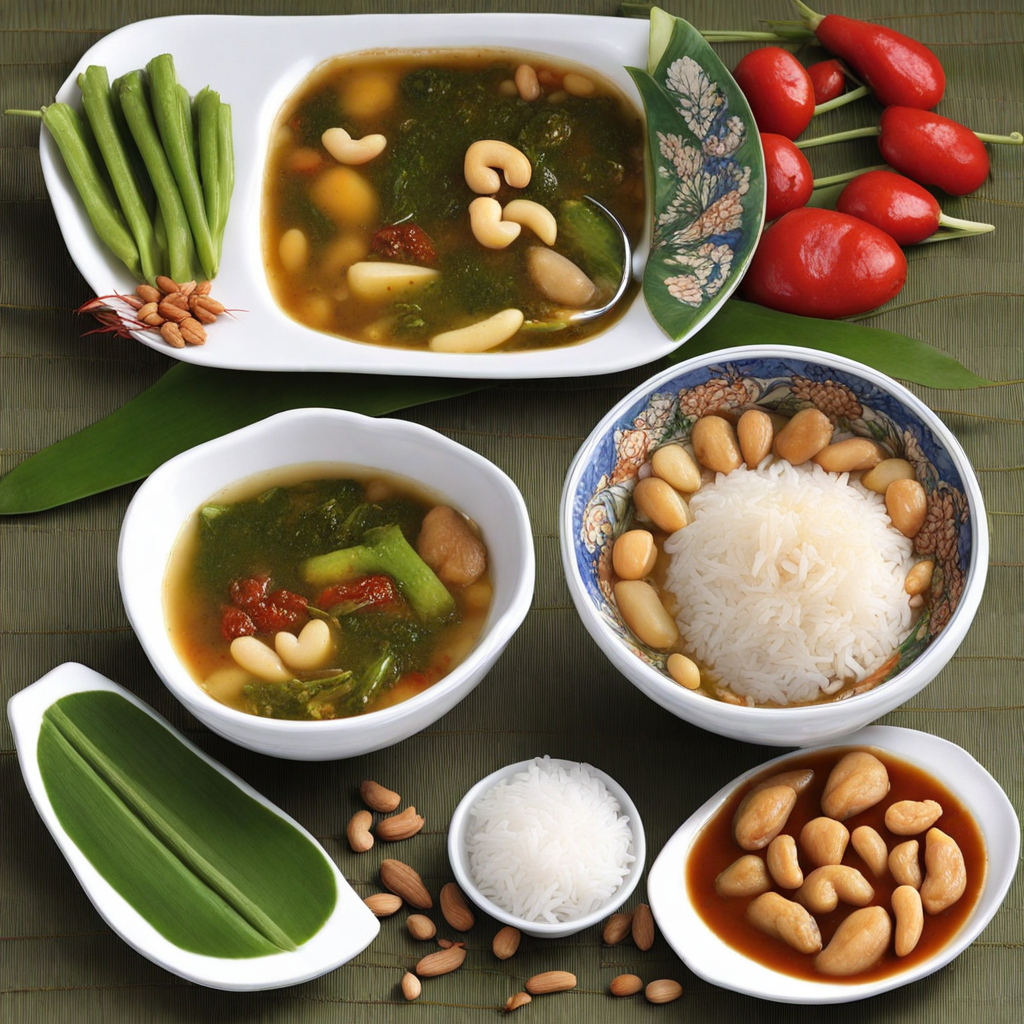Sayur Asem
Sayur Asem is a traditional Indonesian vegetable soup that offers a delightful balance of flavors, making it a beloved dish in many households. The name 'Sayur Asem' translates to 'sour vegetables,' which accurately reflects the dish's signature tangy taste. It is typically made with a variety of fresh vegetables such as long beans, corn, melinjo leaves, and young jackfruit, all simmered in a rich broth infused with tamarind. The tamarind not only imparts a distinct sourness but also enhances the overall depth of flavor, creating an invigorating soup that is both refreshing and satisfying. In addition to the vibrant vegetables, Sayur Asem often includes aromatic ingredients like lemongrass, galangal, and kaffir lime leaves, which add layers of complexity to the dish. The use of these herbs and spices is a testament to Indonesia's rich culinary traditions, showcasing the country's love for bold and aromatic flavors. Each spoonful of Sayur Asem is a celebration of freshness, with the crunchy texture of the vegetables contrasting beautifully against the smooth, slightly tangy broth. Served hot, Sayur Asem is often accompanied by steamed rice and can be enjoyed as a main dish or a side dish. It pairs wonderfully with fried tempeh or grilled fish, making it a versatile addition to any meal. The soup is not only a feast for the palate but also a nourishing option, packed with vitamins and minerals from the assorted vegetables. Whether you are exploring Indonesian cuisine for the first time or revisiting a cherished favorite, Sayur Asem promises to deliver a unique and memorable taste experience that captures the essence of Indonesia's vibrant food culture.
How It Became This Dish
Origin of Sayur Asem Sayur Asem, a beloved Indonesian vegetable soup, has its roots deeply embedded in the culinary traditions of the archipelago. The name "Sayur Asem" translates to "sour vegetables," reflecting the dish's distinctive tangy flavor profile. The primary ingredient that imparts this sourness is tamarind, which is often combined with a variety of fresh vegetables such as young jackfruit, corn, long beans, and melinjo leaves. The origins of Sayur Asem can be traced back to the Sundanese people of West Java, where it has been a staple for generations. Historically, the Sundanese culture has placed a strong emphasis on fresh, local ingredients, and Sayur Asem exemplifies this philosophy. The dish is traditionally prepared using seasonal vegetables, which not only showcases the region's agricultural bounty but also highlights the importance of eating in harmony with nature. \n\n Cultural Significance Sayur Asem holds a special place in Indonesian cuisine, particularly within Sundanese culture. It is often served as a part of a larger meal, typically accompanied by rice and a variety of side dishes, such as grilled fish or fried tofu. The soup is not just a dish but a representation of communal dining, where family and friends gather to share meals and stories. In addition to its role in everyday meals, Sayur Asem is often associated with special occasions, such as weddings and religious ceremonies. It reflects the values of hospitality and generosity, as preparing a large pot of this nourishing soup symbolizes abundance and care for guests. The dish is also celebrated during local festivals, further embedding it within the cultural fabric of the Sundanese people. \n\n Ingredients and Preparation The preparation of Sayur Asem is a celebration of fresh produce, and its ingredients can vary based on local availability and personal preference. The base of the soup typically consists of water, tamarind paste, and a medley of vegetables. Common vegetables include young jackfruit, which adds a unique texture, and melinjo, known for its slightly bitter flavor. The dish is often seasoned with shallots, garlic, and chili, which deepen the flavors. The process begins with boiling the tamarind with water to create a sour broth, followed by the addition of the vegetables. The cooking time is relatively short, preserving the crispness and vibrant colors of the vegetables. This method of preparation not only enhances the nutritional value of the dish but also reflects the Sundanese approach to food—simple yet bursting with flavor. \n\n Development Over Time As Indonesia's culinary landscape evolved, so too did Sayur Asem. The dish has seen various adaptations influenced by regional variations and the introduction of new ingredients. For instance, in coastal areas, seafood may be added, infusing the broth with a briny depth that contrasts beautifully with the sourness of the tamarind. The globalization of food has also played a role in the transformation of Sayur Asem. With the influx of international cuisines, some modern interpretations incorporate non-traditional ingredients, appealing to a wider audience while still paying homage to the classic recipe. This adaptability has allowed Sayur Asem to remain relevant in contemporary Indonesian dining, appealing to both traditionalists and those looking for new culinary experiences. \n\n Modern-Day Popularity In recent years, Sayur Asem has gained popularity beyond its traditional roots. It is now a common dish in Indonesian restaurants both locally and abroad. As more people become interested in healthy eating and plant-based diets, Sayur Asem's emphasis on fresh vegetables and wholesome ingredients aligns perfectly with these trends. The dish has also found its way into popular culture, appearing in cooking shows and food blogs, further enhancing its visibility. The modern culinary scene has embraced Sayur Asem, with chefs experimenting with presentation and flavor combinations, ensuring that this traditional dish continues to evolve while retaining its core identity. \n\n Regional Variations While Sayur Asem is primarily associated with the Sundanese, other regions in Indonesia have developed their own interpretations of the dish. For example, Javanese Sayur Asem may incorporate different spices and a sweeter taste due to the inclusion of palm sugar. Balinese versions might add more aromatic herbs, reflecting the island's rich culinary heritage. These regional variations showcase Indonesia's diverse culinary landscape, where each area boasts its unique flavors and cooking techniques. The ability of Sayur Asem to adapt to local tastes while maintaining its essential characteristics is a testament to its enduring popularity and significance in Indonesian culture. \n\n Conclusion Sayur Asem is more than just a dish; it is a reflection of Indonesian identity, culture, and the importance of community. Its evolution over time—from a traditional Sundanese staple to a beloved dish enjoyed across the globe—demonstrates the resilience and adaptability of culinary traditions. As it continues to be celebrated in homes and restaurants alike, Sayur Asem remains a delicious reminder of Indonesia's rich agricultural heritage and the joy of sharing food with loved ones.
You may like
Discover local flavors from Indonesia







